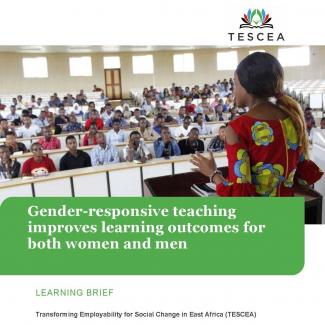
Gender-responsive teaching improves learning outcomes for both women and men
Download publication files
To reduce the gender gap in higher education in Africa, it is imperative that both women and men find their higher education environment to be a safe, open and conducive space to learn and to flourish. The Transforming Employability for Social Change in East Africa (TESCEA) partnership (2018-2021) aimed to transform teaching and learning in university environments so that both male and female students graduate with critical thinking and problem-solving skills, and with the desire to use their skills and ideas to tackle their country’s social and economic problems.
Gender-responsive pedagogy was integrated into the fabric of the TESCEA pedagogical approach, to address the gender gap in the classroom and in wider campus learning activities. The project established a Gender Working Group and took a gender lens to key teaching and learning spaces as part of the process of redesigning courses and transforming higher education teaching and learning.
This learning brief shares lessons from the TESCEA partnership and recommendations for using gender-responsive pedagogy in higher education.
